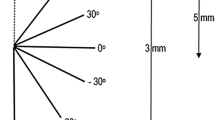Summary
The effects of trophic morphology and behavior of three Hawaiian honeycreepers (Fringillidae: Drepanidinae) upon their foraging rates on the flowers of Vaccinium calycinum are examined. The Maui Creeper (Paroreomyza montana), the Amakihi (Hemianathus virens), and the I'iwi (Vestiaria coccinea) show shifts from a short straight bill to a long decurved bill, from a tongue adapted for insect feeding to one specialized for nectar, and diets ranging from primarily probing for insects to primarily nectarivorous. This diversity is examined feeding on the simple straight tubular corollas of the Vaccinium. Significant differences (P<0.001, t-tests) exist among the birds with respect to foraging rates on these flowers. The I'iwi, with its greatly decurved (64°) bill feeds the quickest (2.09 s/flower) while the Maui Creeper with its rather straight (18°) bill feeds the slowest (3.87 s/flower). These differences are seen to be the result of differing abilities of tongues to extract nectar as well as differing behavioral tactics of floral exploration and nectar extraction. This suggests that predictions of foraging efficiency based solely on bill morphology are not necessarily valid, and that other factors (tongue morphology, foraging maneuvers, and typical food spectrum) must also be considered.
Similar content being viewed by others
References
Baldwin PH (1953) Annual cycle, environment and evolution in the Hawaiian honeycreepers (Drepaniidae). Univ Calif Berkeley Publ Zool 52:285–398
Berger AJ (1981) Hawaiian Birdlife Univ Press Hawaii, Honolulu Hawaii
Brian AD (1957) Differences in the flowers visited by four species of bumblebees and their causes. J Anim Ecol 26:71–98
Carpenter FL (1976) Plant-pollinator interactions in Hawaii: Pollination energetics of Metrosideros collina (Myrtaceae). Ecology 57:1125–1144
Gilbert LE, Raven PH (1975) Coevolution of plants and animals. Univ Texas Press, Austin, Texas
Gill FB, Wolf LL (1978) Comparative foraging efficiencies of some montane sunbirds in Kenya. Condor 80:391–400
Hainsworth FR (1973) On the tongue of a hummingbird. Its role in the rate and energetics of feeding. Comp Biochem Physiol 46A:65–78
Inouye DW (1980) Effects of proboscis and corolla tube lengths on patterns and rates of flower visitation by bumble bees. Oecologia 45:197–201
Perkins RCL (1903) Vertebrata (Aves). In: Sharp D (ed) Fauna Hawaiiensis. Univ Press, Cambridge, pp 368–465
Raikow RJ (1977) The origin and evolution of the Hawaiian honeycreepers (Drepanididae). Living Bird 15: 95–117
Real LA (1981) Nectar availability and bee-foraging on Ipomoea (Convolvulaceae). Biotropica 13 (Repro Bot Suppl): 64–69
Richards LP, Bock WJ (1973) Functional anatomy and adaptive evolution of the feeding apparatus in the Hawaiian honeycreeper genus Loxops (Drepanididae). Ornith Monogr. 15. Am Ornithol Union, Lawrence, Kansas
Author information
Authors and Affiliations
Rights and permissions
About this article
Cite this article
Carothers, J.H. Effects of trophic morphology and behavior on foraging rates of three Hawaiian honeycreepers. Oecologia 55, 157–159 (1982). https://doi.org/10.1007/BF00384481
Received:
Issue Date:
DOI: https://doi.org/10.1007/BF00384481




